One of the most important things a backpacker can find is a great travel backpack. It holds all your gear, it’s with you almost all the time, and in some bizarre, anthropomorphic way, it’s your best friend. I still remember the feeling of coming back from my first solo backpacking trip, and walking around without a backpack. It felt wrong. Like something was missing.
Over the years, I’ve gone through packs like nobody’s business. I’ve never used the same pack for more than two trips, and no matter how many hours I spend either online or in the store, it seems like finding the right pack is always going to be a horrific ordeal.
Discomfort, poorly designed features, dangly straps, sizing issues, and all manner of nonsense have thwarted my path at every turn. It’s tough finding something that fits you properly, and I think, given the high user ratings of certain packs I hate, maybe I just have a bizarrely crooked spine and it’s not their fault.
But I refuse to let them get away with rant-free ease.
“Travel” packs barely exist
Part of the problem is that, up until very recently, the only options were top-loading hiking backpacks, or wheeled suitcases. Other options like duffel bags or school backpacks exist as well, but these are rarely suitable for round-the-world travel.
But since these were the only options, accepting their flaws was all I could do. And besides, high-quality hiking backpacks will stand up to most abuse, and they’ll be super comfortable if they fit you properly. But they’re not ideally suited for travel. Hiking packs work, but we’ve only been using them because nothing else was better.
The problem(s) with hiking backpacks:
Now don’t get me wrong; hiking backpacks are great, and I’ve used them on plenty of trips. Some designs have none of these flaws; it’s just that they usually do:
- Packing inconvenience: Hiking packs are usually top-loading, cavernous cylinders that swallow your gear and you have to dig everything out to find whatever’s at the bottom. You can mitigate this problem with packing cubes, but suitcase-style openings are so easy to manufacture that it’s insulting how rarely they’re implemented.
- Extraneous strap dangle: Hiking packs have all sorts of compression straps and attachment points. These are useful for walking around, but they’ll get scratched up when you throw them in the luggage compartment for a bus ride. And I’m including shoulder and hip straps here, too. If you ever have to check your bags for a flight, they’ll come out a little more damaged every time.
- No locking mechanism: Top loaders usually use a drawstring opening, which offers no security whatsoever against unscrupulous hostel bunkmates. This problem can be mostly solved with a laptop sleeve that can lock itself to a bed, but lockable zippers would be easier (though I’ve softened this requirement, as zippers can be easily bypassed, even when locked).
And in many cases, plenty of hiking packs have dumb design errors anyway, even if you’re just hiking.
The problem(s) with so-called “travel backpacks:”
Several companies design what they call “travel backpacks,” which have better features, solving some of the problems listed above, but they generally screw things up in the meantime as well:
- Size: They’ll make them so gigantic that you have to check them on a plane. Some of these “travel backpacks” go up to 80 liters. I’ve done RTW travel with 20. The carry-on max of 45 liters is plenty! Who the hell needs 80?!?!
- De-hydration pockets: They’ll skip the damn water bottle side pockets and then where the hell do they go?!?!?
- Filthy dirty lie “panel” loading: They’ll forget to make the suitcase-style opening go all the way around, thus defeating the purpose of the panel in the first place.
Sigh.
Which is why I’m so gleefully pleased that certain companies have been designing travel backpacks. Correctly, I might add.
I don’t know why the other people didn’t bother doing it before.
What the best travel backpacks get right
I’ve compiled a list of some of the best travel backpacks for carry-on use I can find. These packs are made for travelers, not hikers. They’ve got panel-loading convenience, not top-loading caverns; they’ve got lockable zippers, not drawstring uselessness; they’ve got carry-on dimensions, and minimal, hide-away straps, not monstrous bulges and streamers hanging from every angle. They can be carry-ons, or they can be checked luggage, without getting ruined.
Oh, and they’re not ugly. To me, that counts. Who the hell ever thought fluorescent orange was sexy? The 80s? Yeah, stay there.
I’ve organized this list by type. Let’s begin:
Option 1: Full size and full-featured
These packs have everything you could want; maximized dimensions, panel access, a laptop compartment, and lots of internal and external organizational pockets. There’s nothing missing.
1) Tortuga Outbreaker Backpack
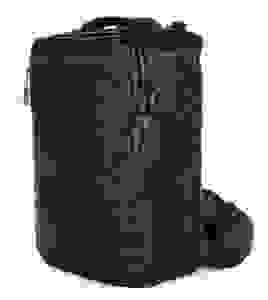
Tortuga was started by a random team of people who found themselves complaining about how they couldn’t find a travel pack that wasn’t awful. They’ve been outfitting nomads ever since.
Expected features on this pack include the full-length panel-loading design, to allow plenty of easy access to everything inside, and the dedicated laptop compartment opens fully flat, so you don’t need to remove your laptop at the security conveyor belt. The inside has even more pockets than the outside, and several compartments (the important ones) feature locking zippers. The “organizer panel” compartment is my favorite feature, with slots for pens, cards, and other small items, and the sheer number of pockets, both inside and out, will offer more organization than anything else you’re going to find.
Tortuga is currently on the third version of this pack, and the new design has a height-adjustable suspension system, meaning it will fit people of all sizes. It also has a seriously padded hip belt, which is rare for these packs, along with a seriously cushioned back panel (with raised ventilation) and shoulder straps. It’s the most heavy-duty suspension system of any travel pack out there, and although it’s significantly heavier as a result, it’s going to excel at carrying heavier loads. They’ve eliminated the ability to stow the shoulder straps and the suitcase handle, however, emphasizing its backpack features exclusively. The side grab handle is also gone, replaced with an extra mesh pocket.
It’s available in 35 and 45 liter capacities, to match the carry-on size requirements of European budget carriers, or North American airlines, respectively. I would say that because the pack features such a heavy-duty suspension system, it actually makes more sense in the 45 liter version. With a full load at that size, you’re definitely going to appreciate the extra cushioning, but at 35 liters, it might feel like overkill, especially since this is one of the heaviest packs out there.
Though Tortuga has released lighter packs, I much prefer the shoulder straps on this model, as they’re much more comfortable on me than either of the new ones they’ve released. If you’re looking for a 45 liter pack, this is as feature-rich as it gets, and definitely one of my top choices at that size.
You can get it from Tortuga. Their blog is also great, with all sorts of packing and travel tips.
Update: I received a test sample of the 35 liter version of this pack, and put it to the test! Check it a detailed review here.
2) Rick Steves Convertible Carry-on
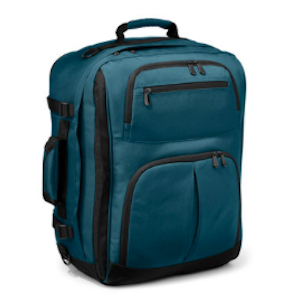
Long before anyone else got started in the carry-on travel backpack game, Rick Steves was galavanting around Europe with his own personal travel gear, designed exactly the way he liked it.
He gave it the features that later became standard on other packs, such as a fully opening panel that allows easy access to everything inside, along with hide-away backpack and waist straps, and suitcase-style grab handles. Exterior pockets are also quite generous, including a dedicated laptop compartment that became a later addition in an updated version.
But it has a few extra touches, such as a separate interior compartment for shoes or dirty clothes, and includes two mesh bags and a removable documents pouch, which you can remove and take with you instead of leaving it in a room. Lastly, the pack is sized to accommodate North American carry-on dimensions, but can expand with a compression zipper in case you stock up on too many souvenirs.
It’s easily the most affordable option on this list, although they do recommend using packing cubes inside to create more structure along the back panel. If you don’t, it can sag quite a bit, putting the weight on your shoulders instead of your hips. The compression straps on the side help with this quite a bit, so just make sure to pack it right, or it’ll feel heavier than it really is.
You can pick it up here.
3) Pacsafe Venturesafe EXP45

Pacsafe is known for its anti-theft approach in everything they do, and this pack is no exception. Not only does it have lockable zippers, but it has zippers that are resistant to the “pen trick,” which is a method thieves can use to break into a pack, even if it’s locked. It’s a huge nuisance that travelers need to know about, but it’s solved here, by placing a redundant set of teeth on the opposite side of each zipper, which prevents a pen from breaking through the chain. It also has slash-proof materials, to prevent hit-and-run theft.
Beyond that, it has a fully-opening suitcase-style main compartment, a laptop sleeve and organizational area in the front, and tuck-away straps. The carry-on dimensions, multiple grab handles, and compression straps make it portable, and versatile.
Pacsafe currently makes this version in a few different sizes, and they have other Venturesafe models available as well (such as the Vibe and X40), but I think this one has the best combination of features, especially in terms of organization. The others are lacking some extra compartments, for example, making this one the most recommendable of their selection. I wouldn’t say it has that much organization, but the organizer panel goes a long way toward keeping everything neat and tidy.
Get it here.
4) GoRuck G2
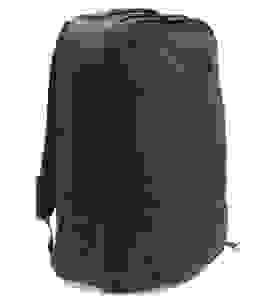
GoRuck has gained something of a reputation for designing some of the longest-lasting gear you can find, built for crazy endurance events and military use. They have packs of several different sizes (including multiple capacities, even if the packs have the same name), but the 40 liter G2 is the one I’m highlighting here.
The pack features a fully panel-loading design, a separate laptop compartment, and another exterior panel-loading compartment for extra organization. It also has those webbing loops all over the place for adding extra accessories or lashing gear to the outside, including a separately available padded hip belt, which I would call a necessity if you’re going for the 40 liter version. The sternum strap is also a separate accessory, so be sure to pick that up if you need it. You can tell it was originally designed for super tough, muscular guys, but it’s nice how they’ve accommodated scrawny weaklings with those extra touches.
As for the downside, the heavy-duty materials and construction make this pack heavy, and pricy…in fact it’s the heaviest and most expensive option listed here, but if you’re big enough to handle the heavier load and you want something that’ll pretty much last forever, the G2 is the one that’ll handle it.
The newly-developed G3, at 45 liters and with an integrated hip belt, nearly made the list here, but the slightly smaller G2 has that extra outside compartment for greater organization, so it just edges out the victory, at least in my opinion. Since the design doesn’t have much in the way of exterior organization, I think that’s an important feature. I do like the G3’s integrated hip belt, however, which is a more natural design element than the G2’s after-the-fact accessory hip belt add-on.
Pick it up here.
Option 2: Svelte and Slim
At 35 liters each, these are for lighter travelers who don’t need to max out on the size, but still want all the convenience of easy packing and laptop compatibility. They’ve got all the important features you’d want, in a slimmed-down size.
5) Minaal Carry-on Backpack
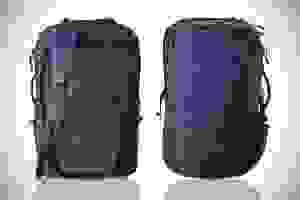
This one is yet another creation in the long, adorable line of things that were invented because people got sick and tired of endlessly having to deal with things that sucked.
This Kickstarter-backed project came about when two long-time travelers decided to make the pack they would have wanted. They set out to create the perfect travel pack for digital nomads, and its design (and Kickstarter success) just goes to show how rarely some of the major players stop to think about the needs of backpackers.
The Minaal has all of the major features you’d expect, including the fully-opening main panel, a separate laptop compartment, hide-away straps, locking zippers, multiple grab handles, and carry-on dimensions, even for the stricter European airlines. It has a few exterior pockets and internal dividers as well, along with a removable rain cover, and a removable, padded hip belt. It’s lighter and simpler than some of the larger packs, and it’s part of the reason I think this relatively minimal level of strap cushioning is kind of all you need at this size. The water bottle pocket is pretty tight, but there’s an elastic band in there that’ll hold taller bottles in place if necessary.
The pack is light, but also unstructured; packing cubes are definitely helpful here, especially since the main compartment tends to flop around quite a bit when you’re trying to pack it. The back panel isn’t too rigid either, so to keep it from sagging, using packing cubes and tightening the compression straps would be a good idea.
Get one here.
Update: This bag is now in version 2.0, and is even better than the original! They’ve sent me a test sample, and I’ve written about it in-depth here.
6) Cotopaxi Allpa 35
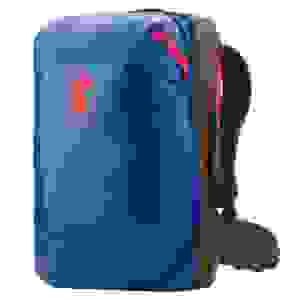
For those who love travel, but only in Punky Brewster colors. But don’t worry, it also comes in black.
This is a relatively new offering, but it does quite a few clever things that look great; it opens up like a suitcase, but splits the gear in half, rather than simply opening with a flap. It has a separate laptop and tablet sleeve, some exterior pocket access (including a way to access the main compartment without pulling open the main zipper), and a neat theft-prevention trick of leaving the zipper pulls on the opposite side of a webbing loop, where they’re hard to yank without fiddling with them a little.
The pack also has a number of optional accessories, such as an external mesh water bottle pocket, to add some customization. The extremely curvy shoulder straps (which tuck away when not in use) are also angled properly for smaller people with more angled shoulders, which I think is actually most people. It even throws in a rain cover, and the price is extremely competitive. I like the way it splits up the main compartment, giving you even more organization instead of using just one big space for everything, and also how it allows you to access those areas without opening up the main zipper. Plus it has those mesh doorways to keep everything in place, so you won’t make a mess even if you need to open up the main compartment. I suppose it could use a bit more mini-organization for pens and cards, but that’s about the only issue I can see.
The lower-right picture shows the pack with optional accessories, like the daypack and laundry bag, available separately.
Get it here.
7) Gregory Border 35
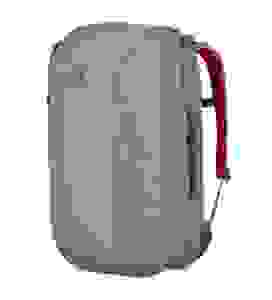
So Gregory is primarily a hiking pack company, and not as widely known as some of the bigger names in the industry, but whose packs I think are designed better than many of its competitors.
Their Border series consists of urban/travel backpacks, and this 35 liter version has not only a full-length panel-loading main compartment, but also a full-length panel loading laptop compartment; this means you just unzip and unfold this compartment, and lay it down on the airport security scanner, rather than removing the laptop at all. It’s quick and easy, and makes airport life just a little more convenient. The several exterior compartments allow for quick access, although there’s not a huge amount of organization here.
It’s missing a couple useful features, however. There’s no hip belt, no side water bottle pocket, and you can’t stow the straps away to use it as a suitcase (although it does have side carry handles). At 35 liters, you might not have to deal with checking the bag, but keep it in mind. Think of it as a budget version of the Minaal. The overall layout is similar, but it’s missing a few of the extra details. Without a hip belt, this’ll work better for larger people, or those who don’t plan on walking around too much with it, such as those who prefer taxis instead of hauling gear across town.
Option 3: Convertible shoulder bags
These options transform from backpack to shoulder bag, so you can carry it whichever way you want.
8) Tom Bihn Aeronaut
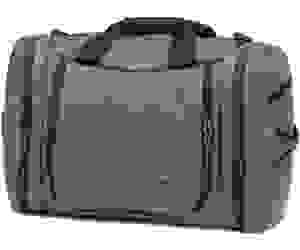
Tom Bihn is known for exceptional attention to detail, tiny little organizational perks, and super tough materials. They tend to win over fans for life, and that’s how long their bags seem to last, too. Many of them end up collecting the whole set.
They also provide far more compartmentalization than most other options; instead of one big compartment and a few extra pockets on the outside that are really just flat slots, they tend to have multiple three-dimensional areas, for splitting up large items, and not just little ones.
Pictured is the Aeronaut, a convertible duffel bag with disappearing backpack straps that zip away when you don’t want to use them, along with an optional waist strap, and an optional shoulder strap for shoulder bag mode. The main compartment opens up with a U-shaped panel, allowing for far more convenient loading and unloading than a typical straight-zipper duffel would allow, and the spacious side compartments on either end allow for plenty of organizational access, even for large items, without having to open the main section. The 45 liter version is a full-size pack, but it comes in a 30 liter version as well, for those strict European carriers.
Though it has plenty of compartments, it doesn’t have anywhere specifically intended for a laptop or a water bottle, though you could easily find homes for these somewhere in the setup. Also, keep in mind that the optional hip belt is just a strap, so it’s better for shorter walks. I tend to think of this design primarily as a duffel bag, with the option of backpack straps if necessary, but with the minimal hip belt and non-meshy back panel (which is just the regular exterior fabric of the rest of the bag), I’d try to avoid all-day use while in backpack mode with this one.
Get it here.
Update: I got a chance to test the smaller version of this bag (30 liters), but the features are identical, so if you want to see a ridiculously detailed review, take a look here.
9) Patagonia MLC
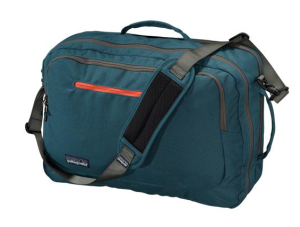
The MLC stands for “Maximum Legal Carry-on,” and thus it’ll give you plenty of room. It opens up all the way like a suitcase, but splits the cargo in two, storing some of it in the “door.” This keeps things more organized than a standard compartment, especially for dividing clean laundry from used clothing. Exterior compartments round out the organization as well.
It has carrying handles, a shoulder strap, and backpack straps, a laptop compartment, and Patagonia’s ironclad guarantee. It’s a solidly built carry-on that’ll last you for years. I will say that because it’s primarily designed as a shoulder bag, without a mesh back panel and no hip belt, that it’s better to think of this as a shoulder bag than a backpack. You might be fine carrying it through an airport for a little while, but you probably wouldn’t want to go on any long walks or hikes with it. It does have a sternum strap, so that helps, but I wouldn’t think of it as a dedicated backpack.
This model is known as the “Headway,” although they have another version known as the “Black Hole” MLC, with a super weather-resistant fabric.
Pick it up here.
Option 4: From the outdoor world
These last few options are from outdoorsy companies, whose travel-specific options are also pretty solid.
10) REI Ruckpack 40
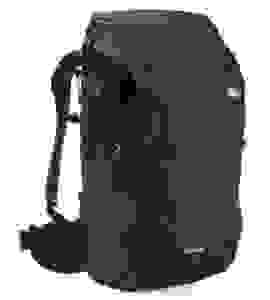
REI has had a place on this list for quite some time, although they’ve changed things up with new models every so often; the current incarnation of their travel pack is the Ruckpack 40, available in both men’s and women’s versions.
The Ruckpack is geared a bit more toward the outdoorsy crowd than digital nomads, with super-tough straps and a giant hip belt, but no laptop compartment. There’s a hydration bladder sleeve that could double as a laptop sleeve, but you’ll need to bring your own cushioned sleeve if you want protection. That’ll work, but it’s definitely more outdoorsy than tech-oriented, especially since it throws in a rain cover.
Still, it’s (nearly) a full-size pack, with a serious suspension system, which is easily its best feature, especially compared to some of the other minimal packs that are more for airline transportation than long hikes. It also has easy access from both the top and the fully-opening front panel (integrated together with a single zipper), and plenty of exterior organization, including small pockets for lots of small items. Those outer pockets do have a compression strap over them, which is a little odd, since it limits accessibility, but it’s a minor safety feature as well, since it’s just a bit more fiddly to deal with than just a zipper.
It’s just a bit too tall to be a carry-on, but the good news is that the top pocket squishes flat, so that’ll bring you into compliance with strict airline requirements, as opposed to some of the other, more rigid designs that don’t allow this. And if you do check the bag, the straps tuck away.
Get it here.
That’s the men’s version, but don’t forget there’s a women’s version there, too (and for a much lighter but otherwise similar pack, check out their Trail 40).
11) Osprey Farpoint 40
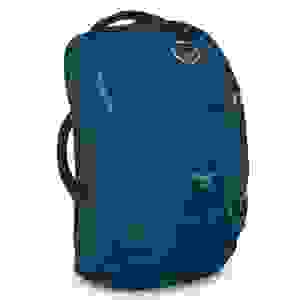
So I’ve decided to add this to the list, as it’s a popular pack with a great reputation, and it’s definitely worth checking out. It’s just that it does a few things that annoy the hell out of me, as is the case with all Osprey packs, but I’ll get to that in a minute.
First, the good: It’s a carry-on sized backpack with a full-length panel loading design, a dedicated laptop compartment, and hide-away shoulder straps. And those are good shoulder straps, and the waist belt is great, too. They really didn’t skimp on this feature, and it’s also available in two different torso length sizes, so it’s definitely going to be comfortable. And by the way, it’s probably going to be significantly more comfortable than the Osprey Porter 46, which is incredibly similar, but comes in just one size, and with daintier straps. I like how it has an organizer panel on the front, and its compression straps flatten things down by closing its semi-rigid sidewalls, which is a clever way to handle things.
And now, the bad: Osprey never ceases to amaze me with their insistence on using non-stretchy mesh water bottle pockets, with compression straps that go right over the pockets to make them a million times harder to use. I really don’t get it. I also find it to be something of a nuisance how the compression straps block access to the main zippered compartment, meaning it’ll be kind of a hassle getting into and out of the bag. The Farpoint has small external pockets, but the big ones are stuck behind the straps, in a way that annoys me a little more than some of the other packs listed here.
Still, it’ll definitely work, and its hiking pack pedigree means it’ll be a comfortable pack to carry. Another odd, but workable feature is how it carries the laptop on the side farthest from your back. I initially didn’t appreciate this feature, but as laptops become smaller and lighter, the weight distribution is less of an issue, and it protects it from getting squished between your back and the rest of the load.
Get it here.
(You’ll notice the larger versions have a detachable day pack, but not the 40 liter version)
So what makes a good travel pack?
You’ll notice that these packs generally have a number of features in common, some of which I mentioned as necessities, and some of which are easier to see once you line them all up in a row. These are the features of a good carry on backpack ideally suited for travel:
- Carry-on size: 45 liters is plenty for lifelong, indefinite travel all over the world. I did it in 20. You can do it in 45. And if you still want the “extra” pack for quick day trips, consider a compressible one. By the way, keep in mind that certain regional European carriers have stricter limits; 35 liters will likely be fine for them.
- Hide-away straps: But if you do want to check a bag, you certainly can. The straps tuck away so they can’t get snagged or damaged, which is also useful for stuffing them into overhead bins or under a seat.
- Multiple carrying options: You’ll notice each of these packs has at least two handles, always in the same place; the top, and the side. This allows you to carry it like a briefcase, or pull it out of an overhead bin. Plus, the aforementioned backpack straps and occasional messenger bag straps let you carry them however you feel like it.
- Internal compression straps: You pack the bag while it’s flat, then turn it upright. The compression straps keep everything stuck the way you packed it.
- Minimal external compression straps: No dangly silliness to get stuck on whatever. They’re useful, sure, but dammit, why don’t the hiking companies have the dangly end hang on to something so it doesn’t dangle?
- Laptop compartment: Our lives exist in the digital ether. I’ll tell people to skip the laptop if they’re not going to use it, but digital nomads need it, and most people will want one anyway.
- Locking zippers: It’s just that easy to keep your bag protected. Other bags have steel mesh reinforcements throughout the bag, but…the cost/benefit ratio isn’t so ideal. Locking zippers are easy, and hugely helpful (though I’ve recently seen techniques to bypass the lock, so I’ve softened on this as a requirement).
- Flat packing: The whole thing lies down so you can pack it like a suitcase. This is incredibly useful. I don’t know why it’s so rare in the hiking world.
Potential areas for improvement
I do, however, have some problems with certain aspects of carry on backpack designs. Now remember, I’m a nitpicky bastard that can never be satisfied, but dammit, it’s because I’m right. But keep in mind these are issues worth thinking about, rather than deal-breaking problems.
- Minimal hip straps: Transferring the load to your hips makes a huge difference. It’s the difference between “I need a massage” and “let’s go party.” For large, muscular specimens of masculinity, this is probably not such a big deal. It’s also easy to manage if you go straight from the bus station to the hostel, but I’ve often found myself wandering around town with my pack, and it’ll probably happen to you sooner or later as well. It would be nice to see detachable hip straps as an add-on option, though as mentioned, a few of the above options (Tortuga and REI Vagabond) have more serious hip straps than the others, and a simple strap can go a long way in improving the comfort of smaller gear setups.
- Minimal ventilation: This is another problem that arises from longer walks. If it’s winter or you don’t sweat much or you’re going straight to the hostel, good for you. If you plan on walking around for an hour, it’s going to be an issue. I’d normally say the trampoline-style back panel is great, but it’s tough to recommend it for the problems these packs are trying to solve. These packs are supposed to go through luggage checks with no problems, and the trampoline back would need to be protected in order to accommodate that. However, a raised lumbar pad and raised shoulder blade pads would go a long way in diminishing the ventilation problem, without sticking out too much.
- “Water bottle pockets” that don’t fit a water bottle: I’ll start by pointing out that most of the options above are fine in regards to this problem, but I will never stop complaining about inadequate water bottle pockets, because goddammit where the hell do they go?!?!
But again, these are just potential problems. The hip strap issue is likely the most objectively serious, and it’s definitely something to think about if you expect to be walking far and wide on your worldly adventures.
But, all in all, I like these designs. I also like the existence of these designs. I expect carry-on, hybrid packs like these to become increasingly popular, because they’re so efficiently designed to accommodate the needs of lightweight travelers who still need backpack straps, and once you get one…you’ll never need anything else.

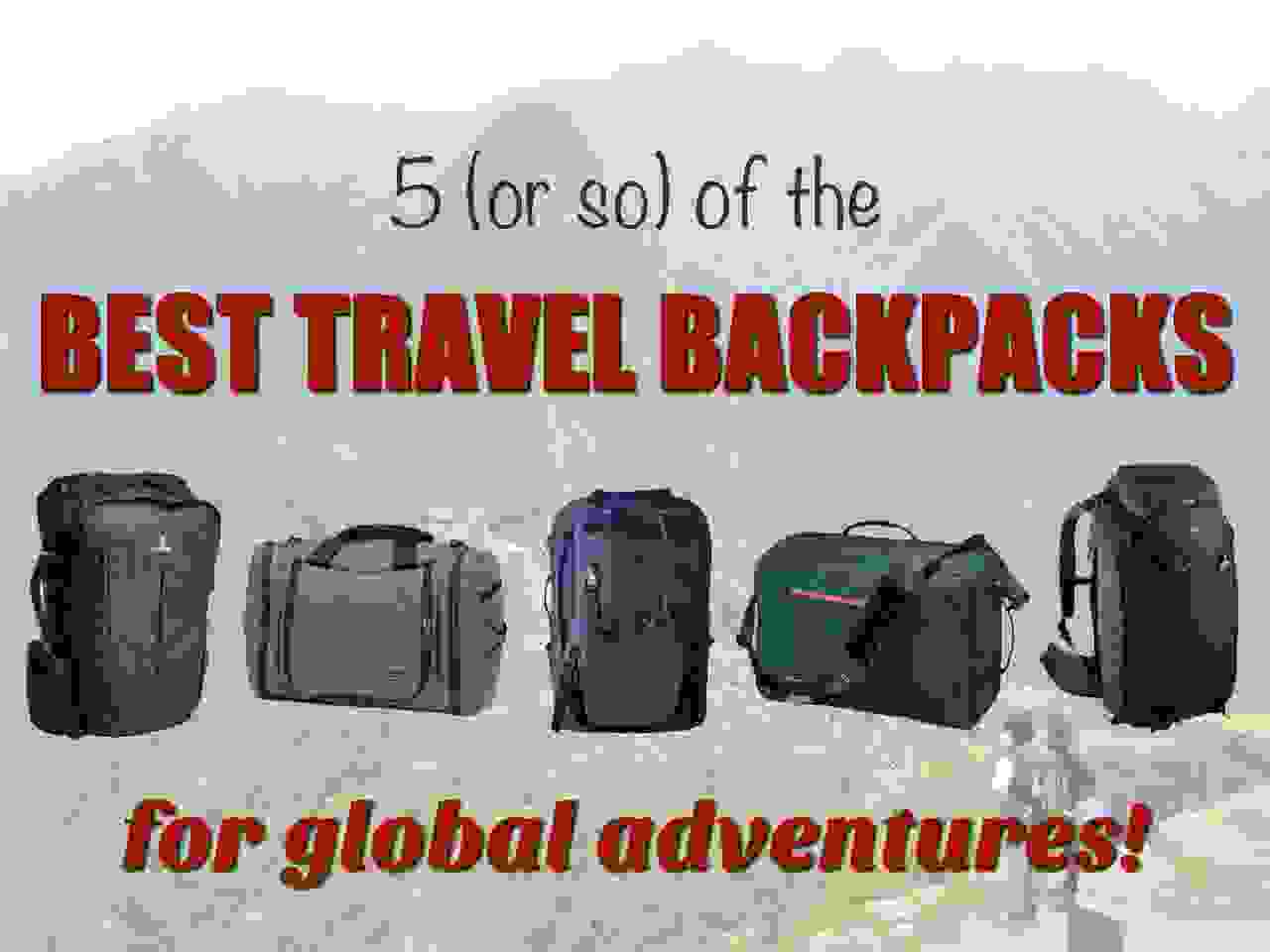
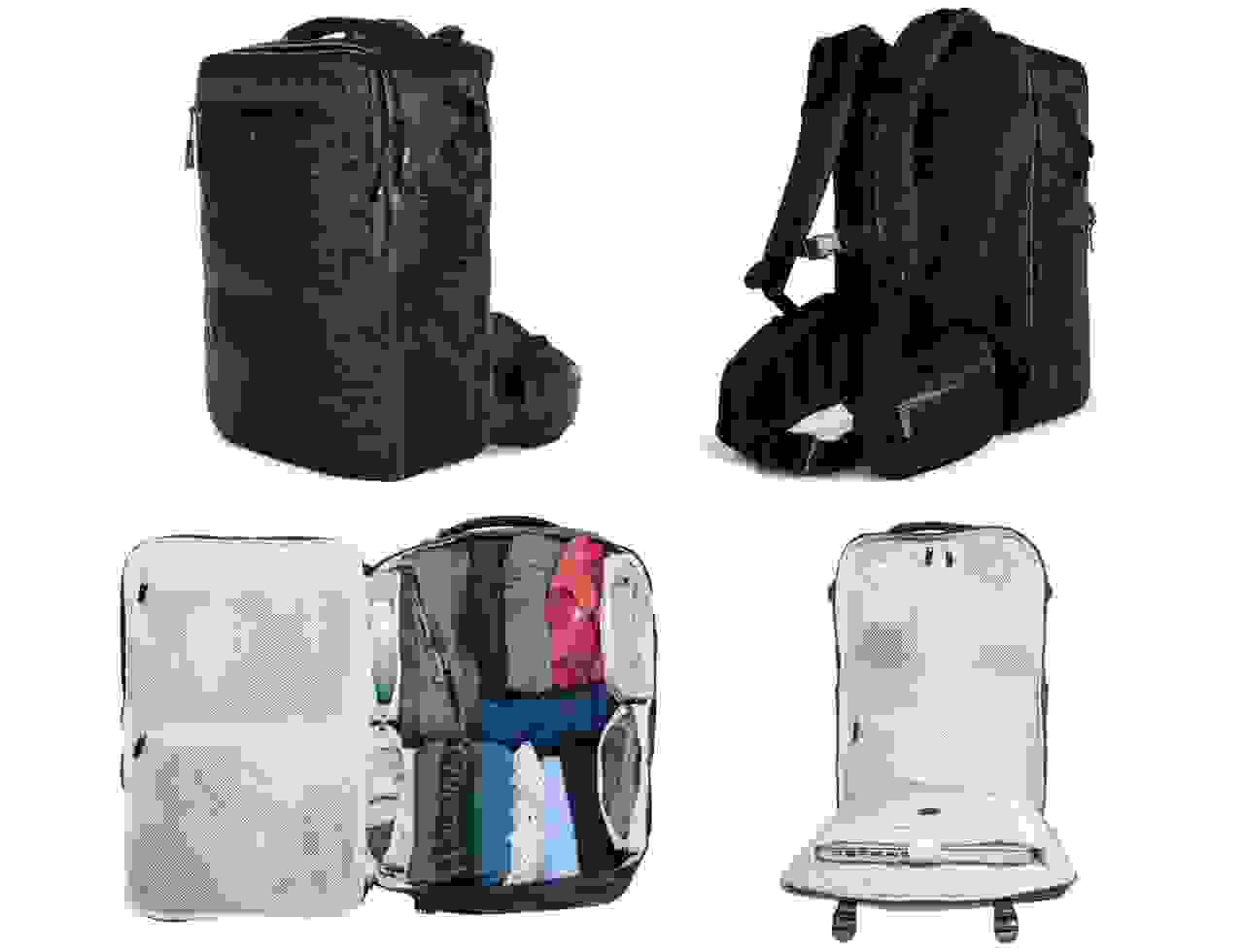
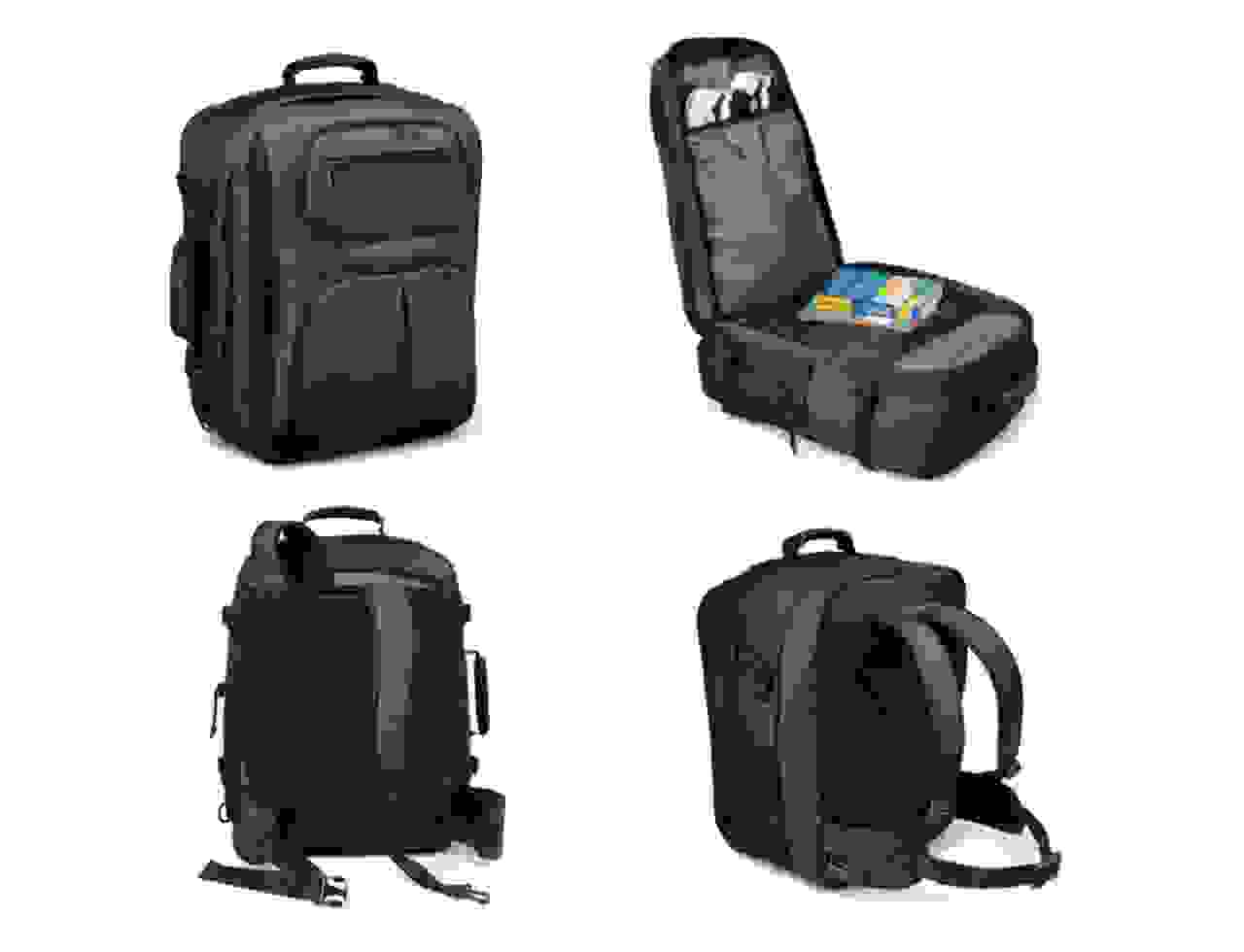
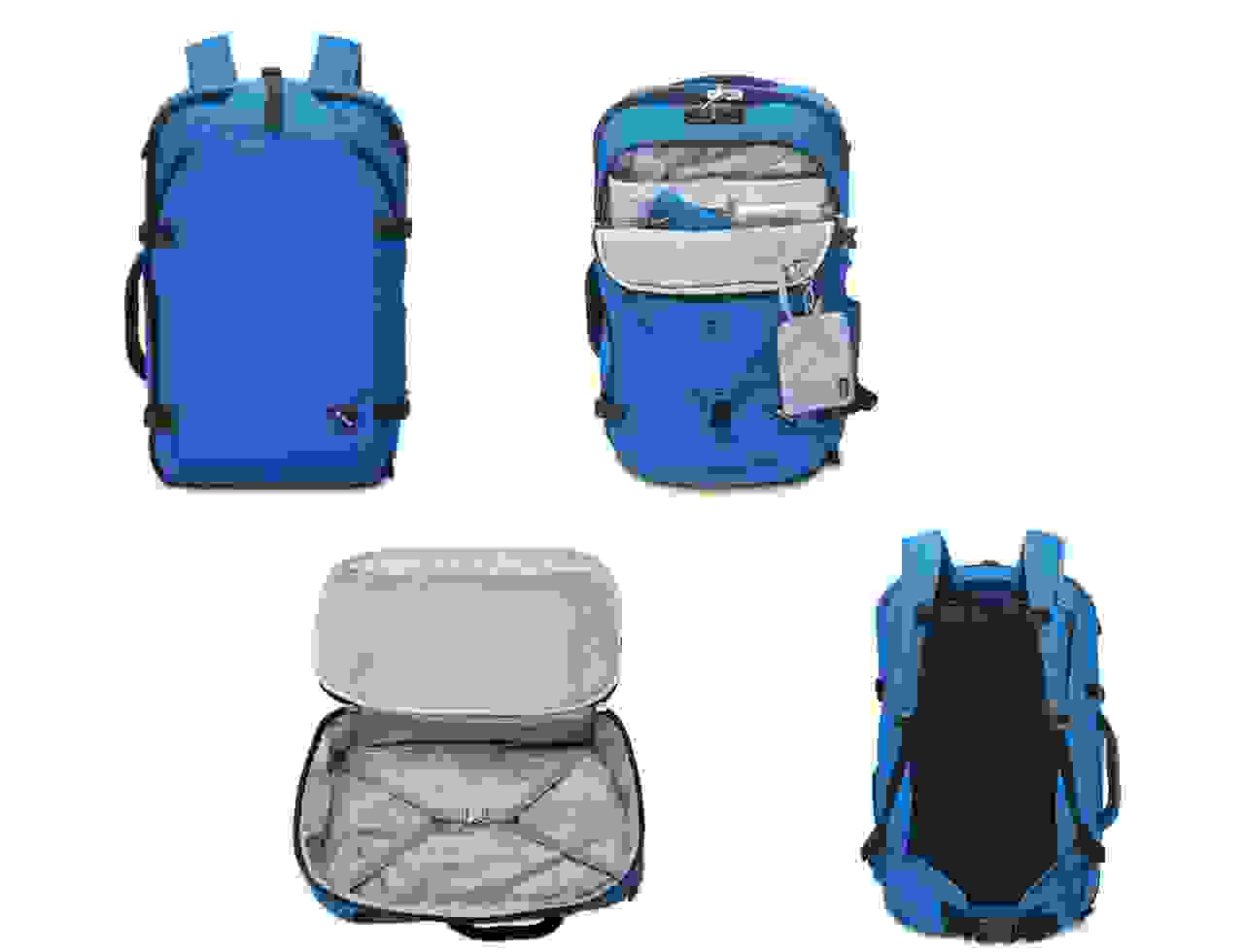
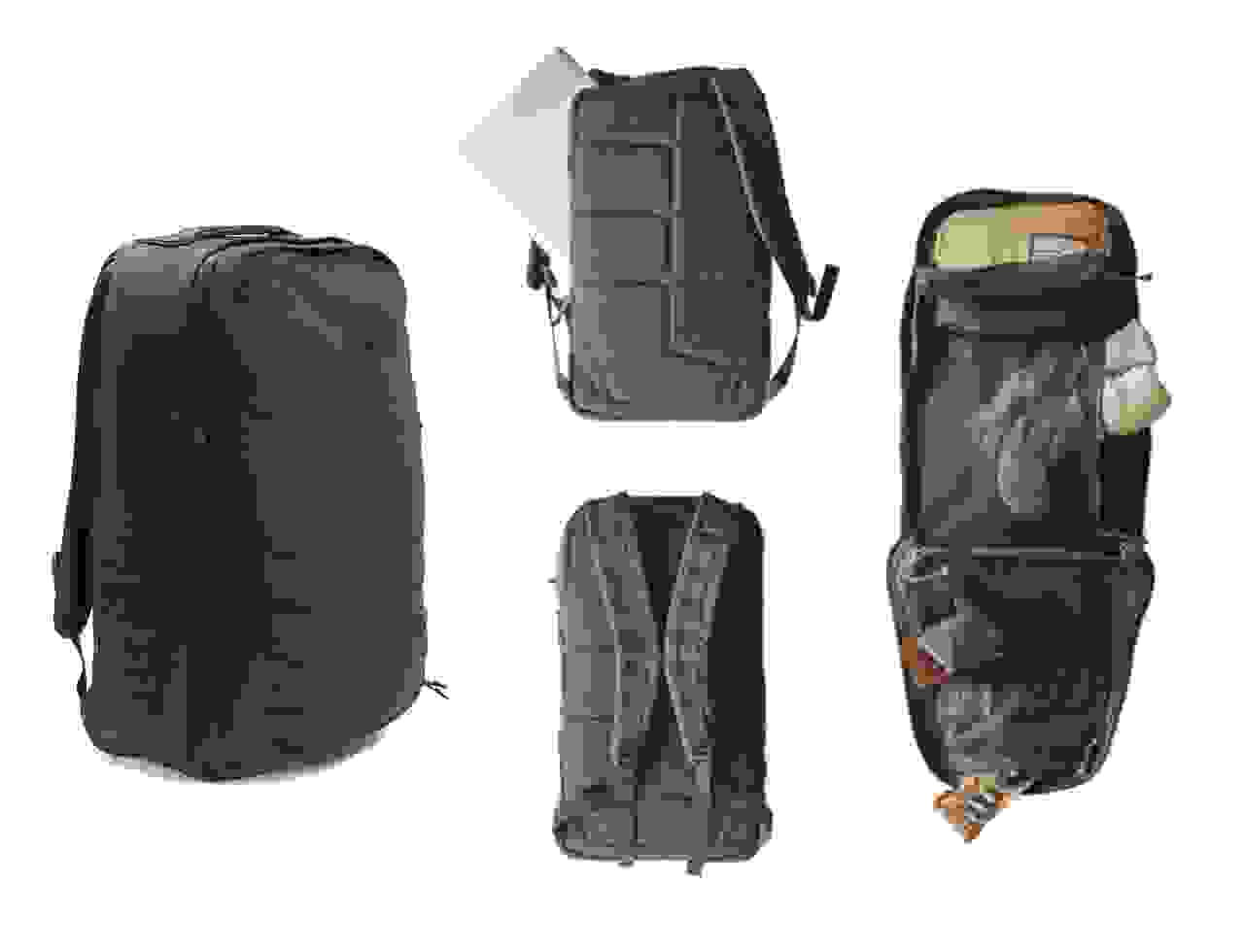
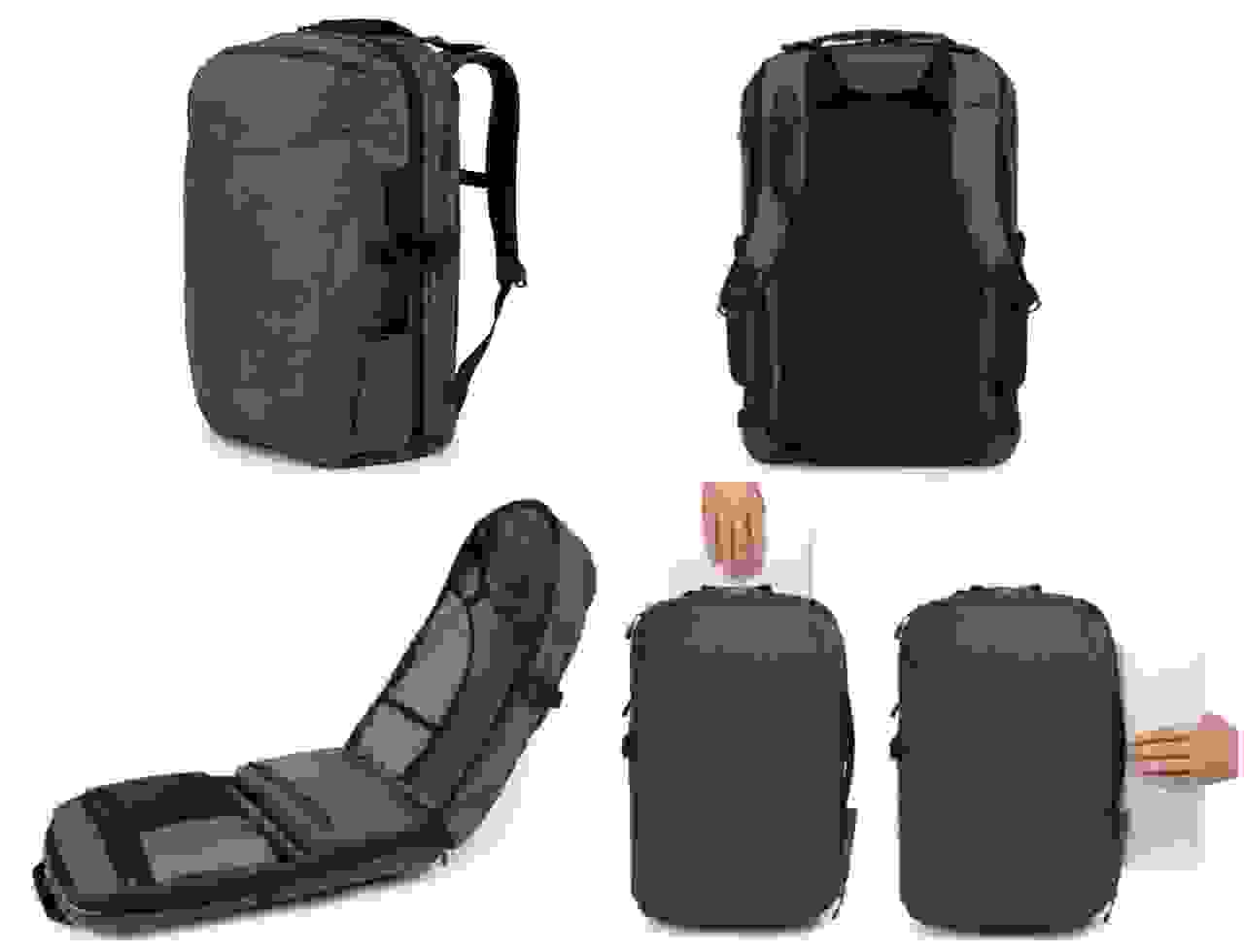
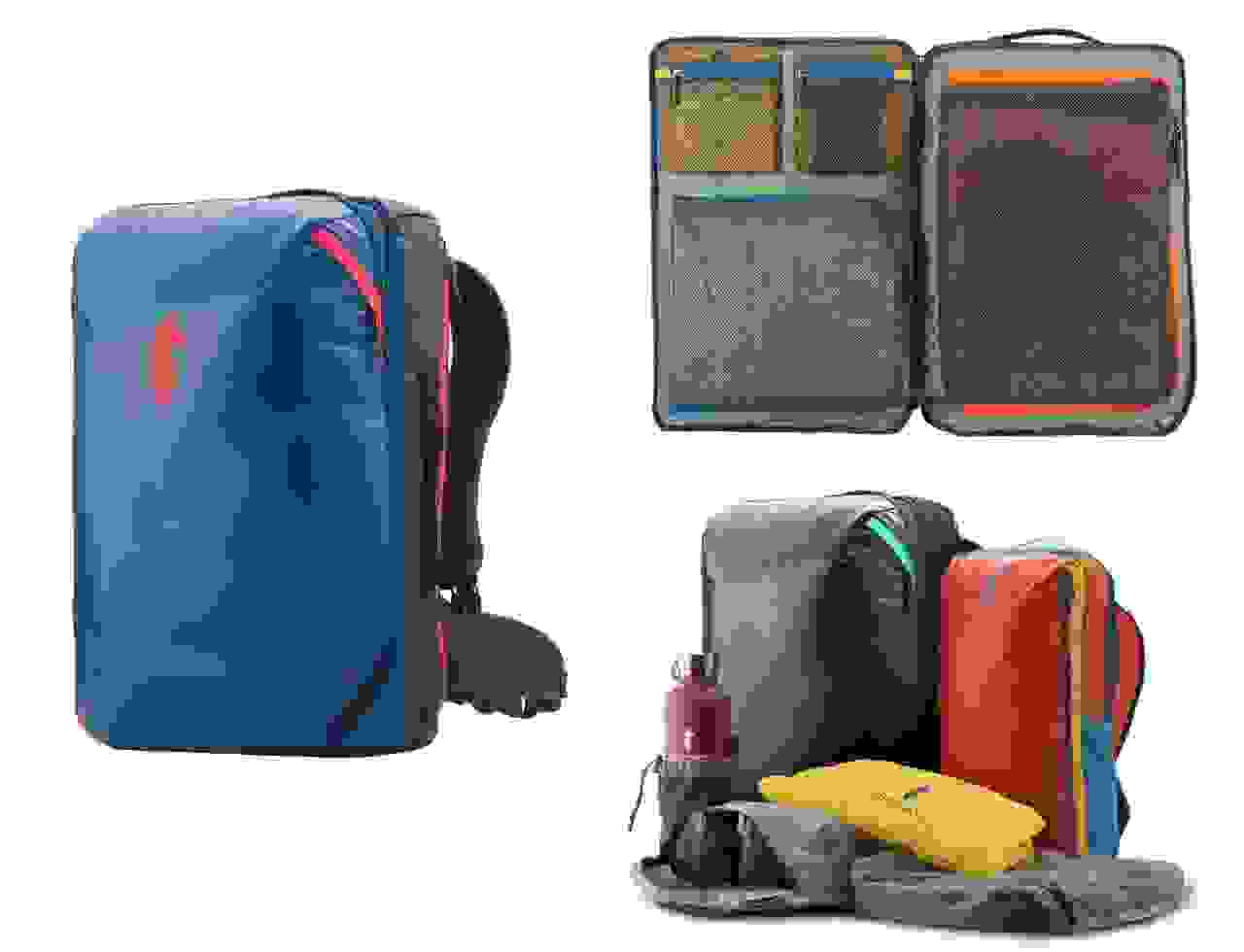
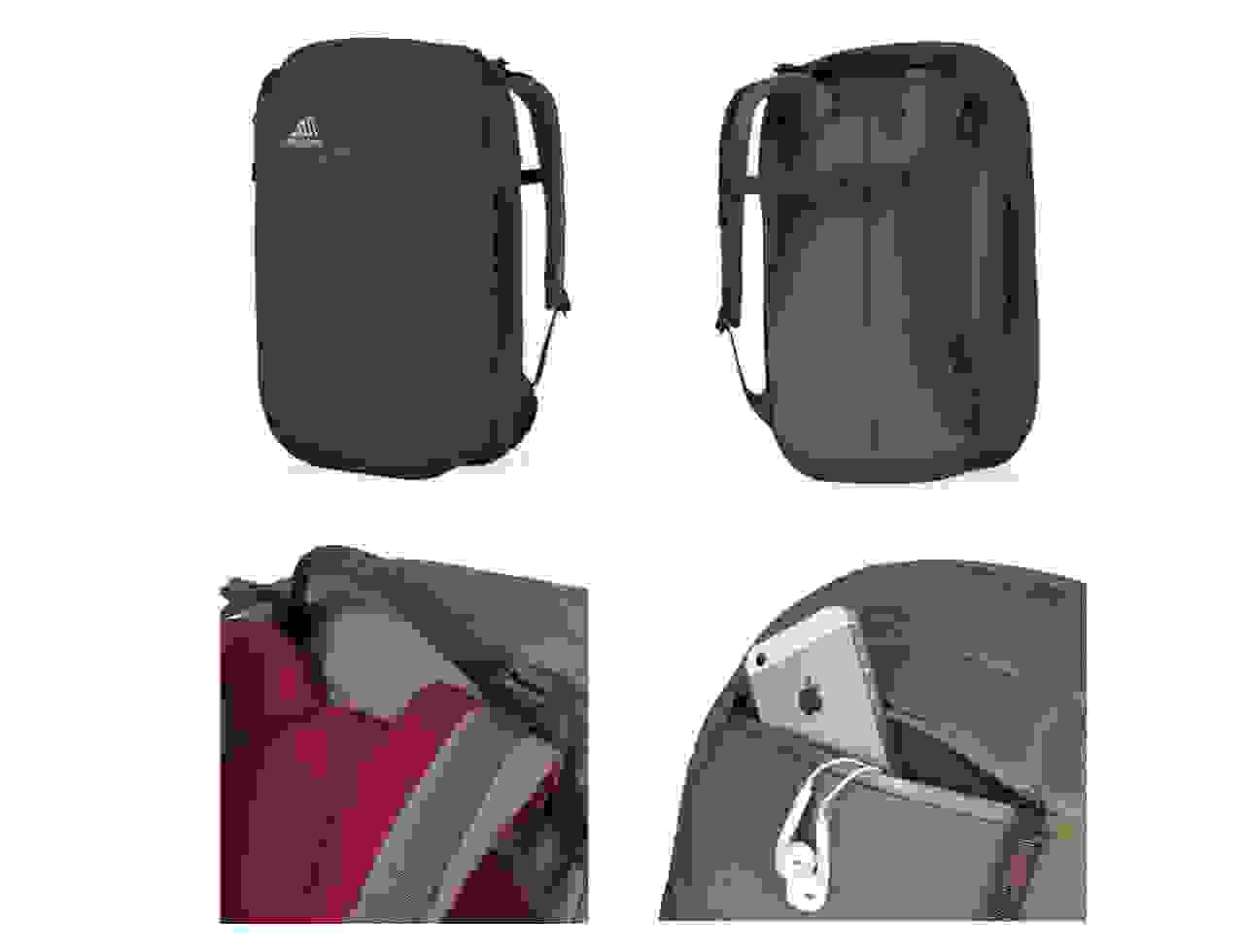
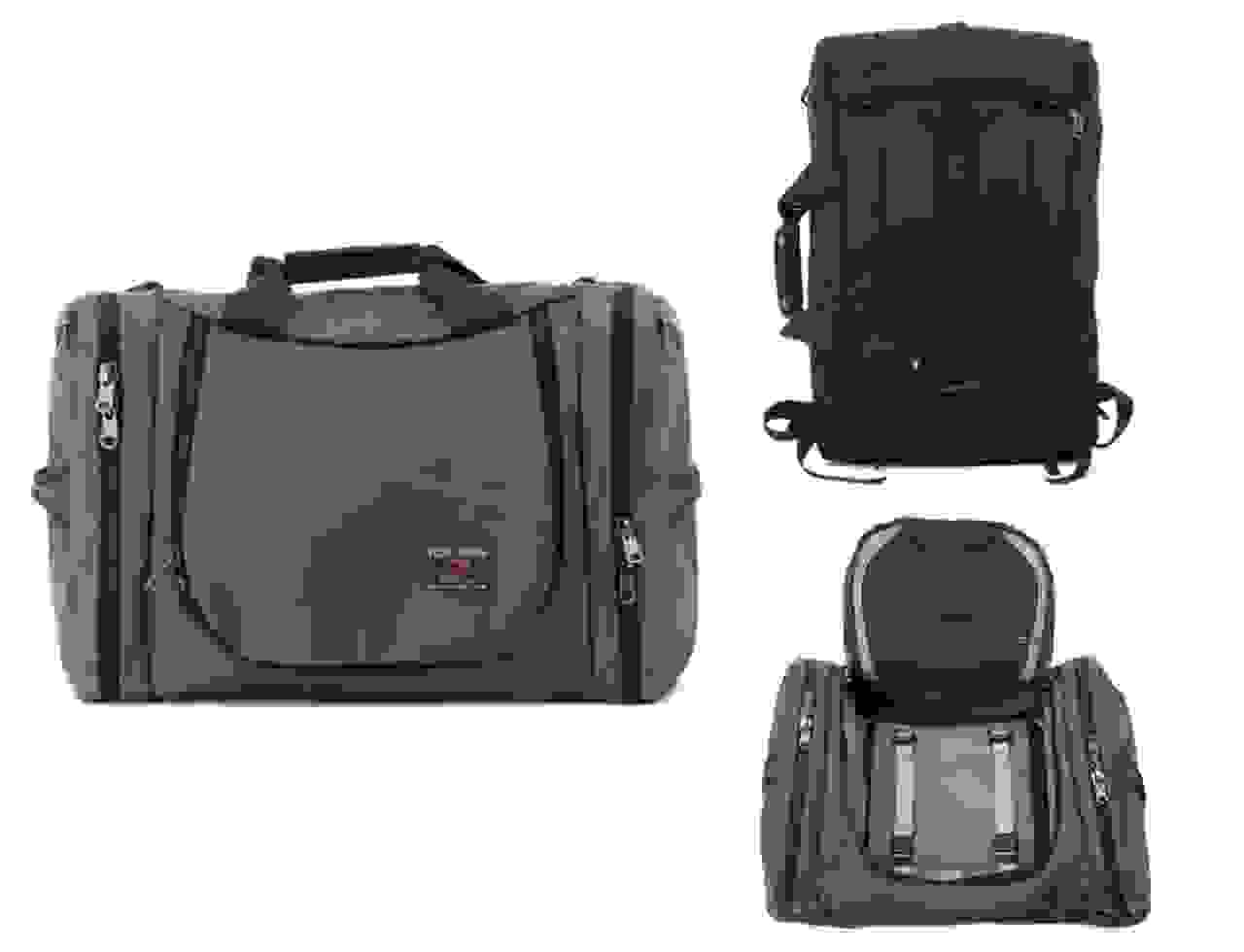
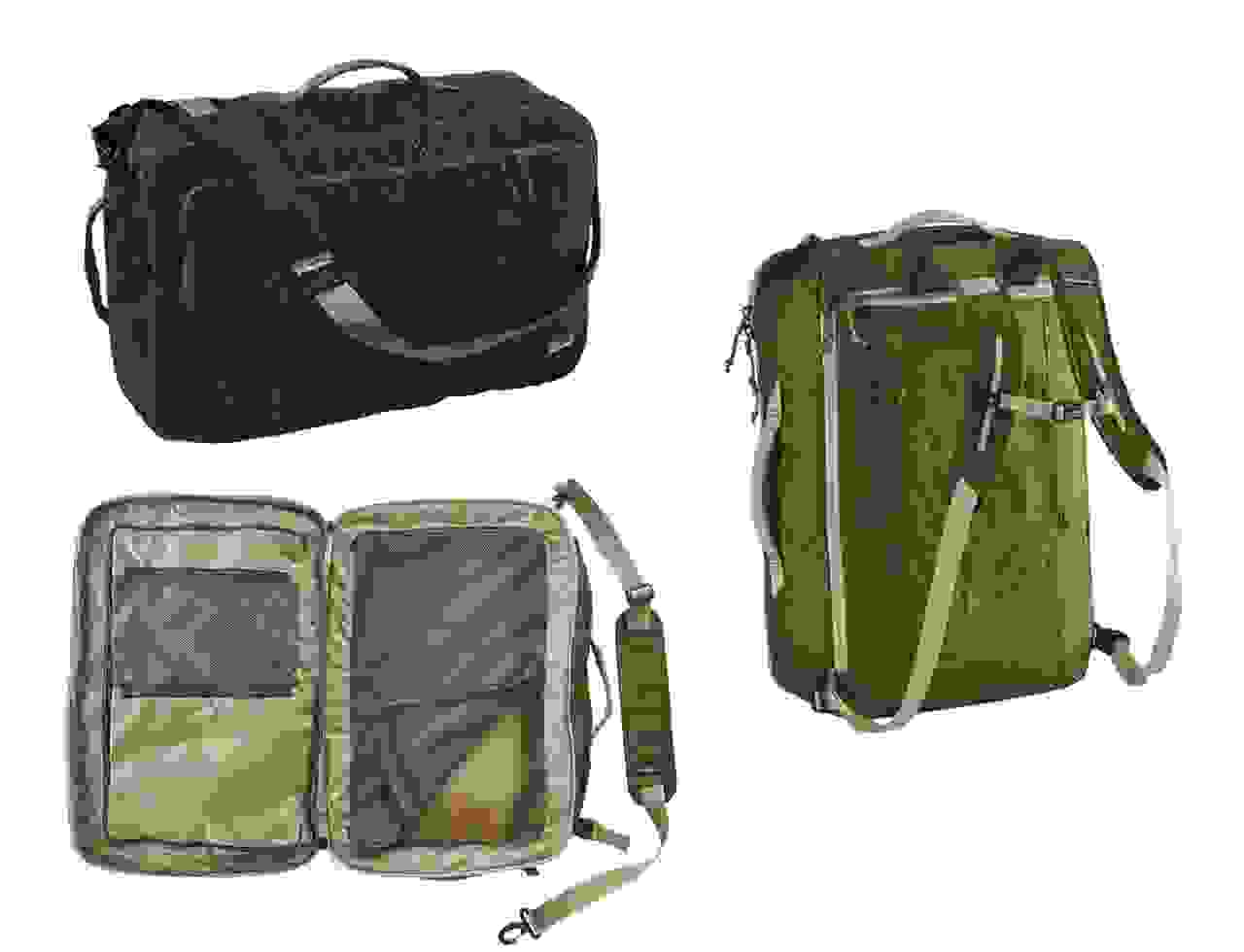
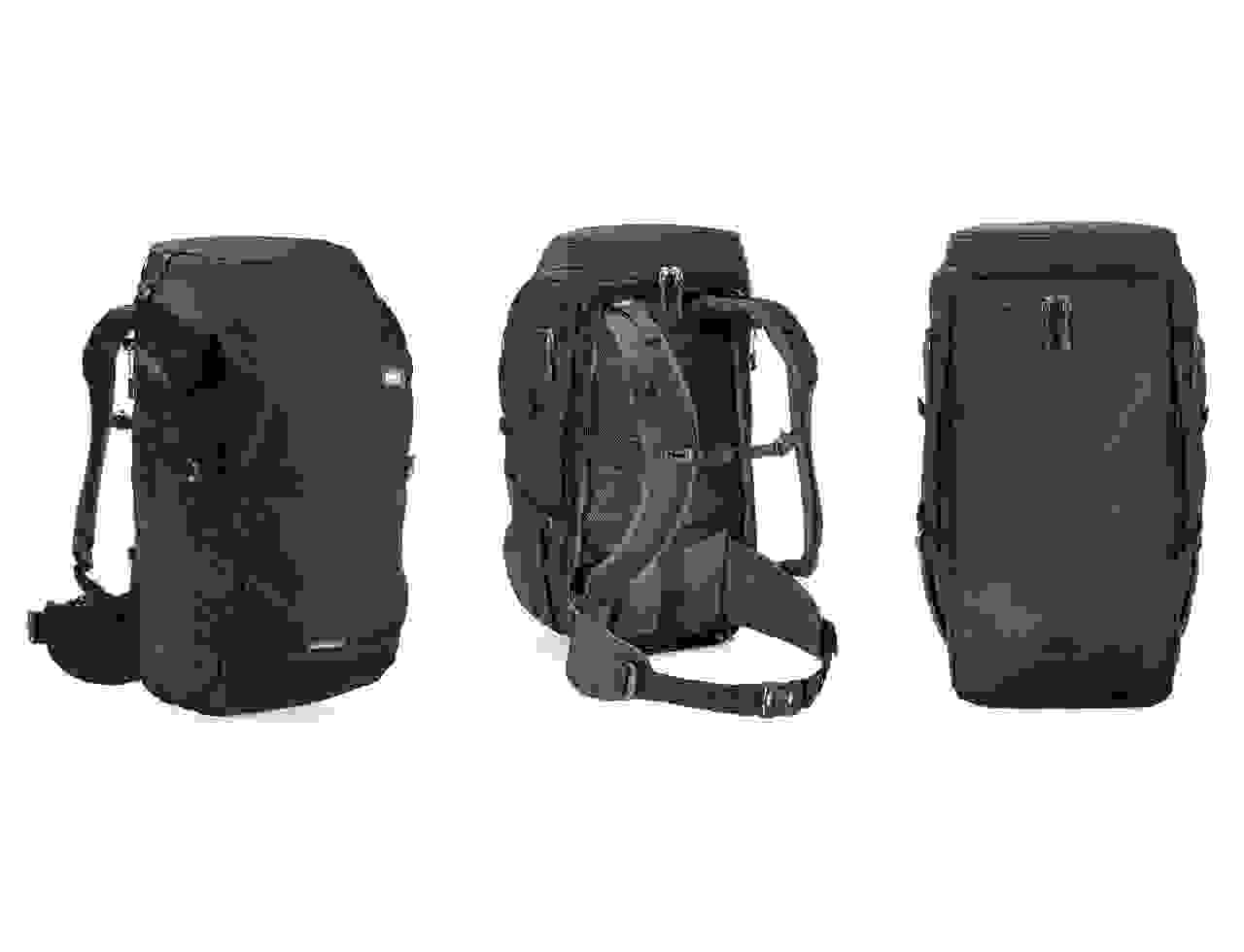
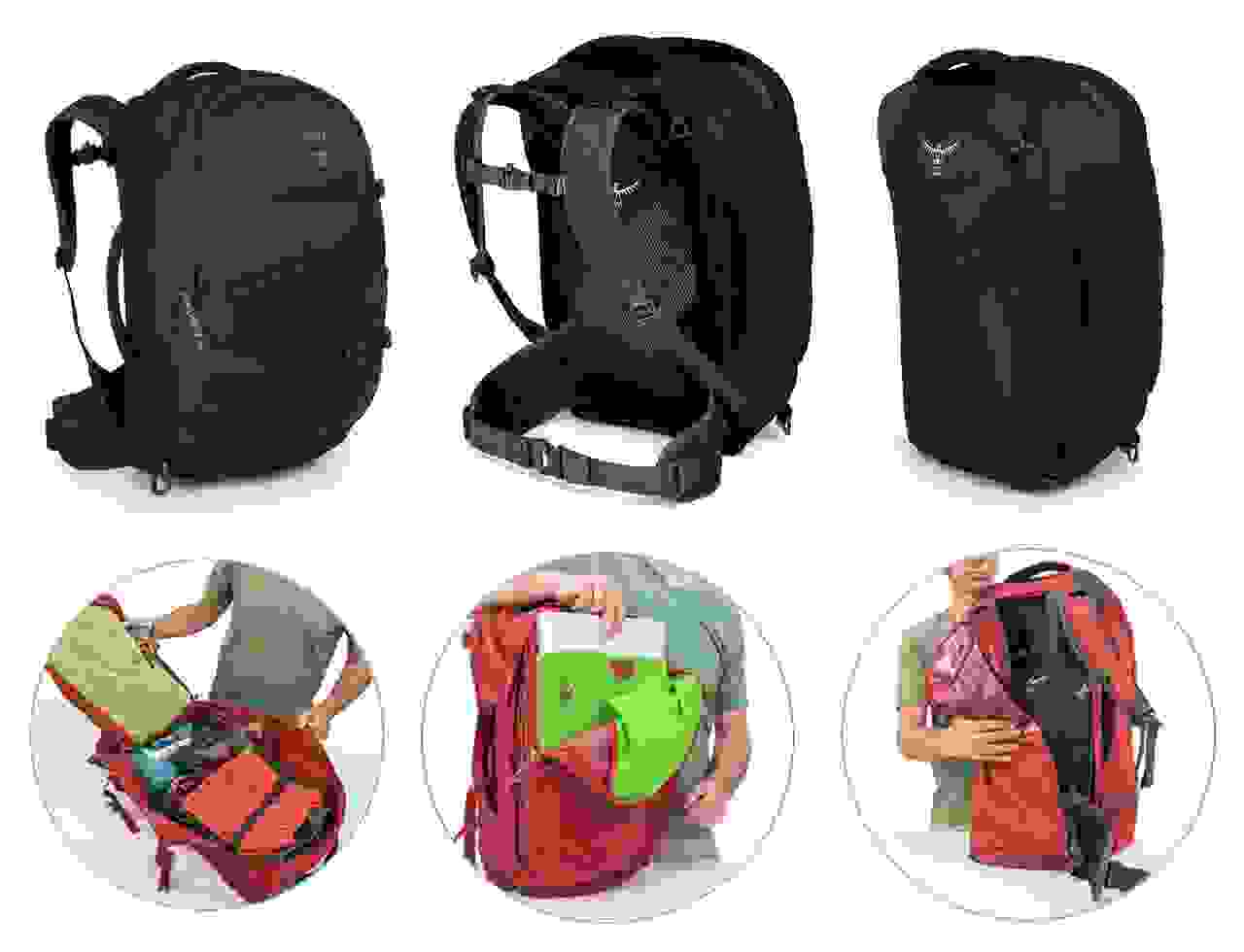



Do you not like the Timbuk2 Aviator?
Kind of. I like the overall design, the grab handles on both sides, the hip belt, and the appearance. But it’s much, much heavier than it needs to be, and it’s fairly small. Also, in order to access the main compartment, you need to unclip 5 buckles, and then unzip the zipper. You can just access the top compartment instead, which isn’t so bad, but I thought it had just a few too many issues. But for the most part, it’s just the size. I try to recommend gear that’ll work for most people, and although you could certainly travel with just 28 liters, most people wouldn’t want to. I do kind of like it though.
Ugh, didn’t notice the weight, and had to make a quick decision before leaving for France on Wednesday. I actually like having to keep the load small. I went across the US with 20 liters, so this should feel luxurious.
Truthfully, I want to look at my pack and be excited when I see it. Despite your flawless logic, I just found them so uninspiring. I’m sure the day will come when I regret the buckles, but already feel in love with the thing.
Grateful for your detailed insights and entertaining posts, and thanks for the quick response!
Hey I just wanted to follow up with gratitude after our trip to France. Your analysis was spot-on regarding the Timbuk2 Aviator. I didn’t mind the many buckles, and I LOVE the bright orange interior that makes it easy to find stuff in any level of lighting. Lots to love about this thing. BUT it is indeed too small, and the silly weight makes it a deal breaker. I was working much to hard for far too little stuff. I took care to keep it perfect and returned it when I got back. Thank you for your guidance!
I think my next step is to try the Kelty Flyway 43 and hope to dodge your metal rod issues. The ratings on the thing are as good as the price.
Great site and gear reviews!! You’ve made me feel better about my travel gear obsession. :)
I’m trying to select a bag for an impromptu trip to SE Asia next month. From your reviews, I am looking at the Tortuga, Minaal and Tom Bihn’s Aeronaut & TriStar. I am currently using a Red Oxx Air Boss, which is great for business travel, but the lack of backpack straps throws it out of the running (pros & cons on the Air Boss listed below for those considering it).
Besides the backpack straps, I want something that you could take to a business meeting. So out with the excess straps and the garish logos/colors. The Aeronaut looks a little too much like a duffle bag to me, so doesn’t grab me visually. The TriStar (33L) and the Minaal (35L) both concern me on size a bit. I don’t think it will be an issue for this trip, but I would like to use it for biz trips in future where I need to travel a bit heavier. It looks like Tom Bihn just raised the price from $280 to $315 on the TriStar, plus once you add in a laptop sleeve, compatible storage sacks and shipping, you are pushing the $500 range…ouch! So it better be useful for multiple trips! The Tortuga and Minaal both looks intriguing, but I live in Canada and Minaal won’t accept international returns, so I’m reluctant to throw $350 at a bag site unseen with no option to return it. Also, all the bags I like are on back-order into June, so I might SOL on all four options…haha.
Any suggestions or recommendations?
If I can’t get my ultimate bag in time, I also picked up a simple 25L pack from MEC. While I’m religious about carry on, I’m not sure I can go that minimalist with the itinerary (beaches, hiking, cities, nightclubs, biz meeting, etc.). I’ve added some Icebreaker merino wool clothing, but not sure I can get down to 3 changes of clothes as you had on your packing list. However, I’m tempted to try the “ultra light” as it’s only a 2 week trip.
http://www.mec.ca/product/5034-840/mec-shuttle-iv-travelpack/?Ns=p_new_to_mec_date%7C1&f=10+50007+50806
The Red Oxx Air Boss
What I love about it:
-Bullet proof material and zippers (although might be heavier than need at 3.4lbs)
-Full zippers to allow flat packing
-Minimalist design so you can configure it to your needs. I hate travel gear that builds pockets sized for today’s technology and becomes outdated (e.g., Blackberry to iPhone). Sometimes I take a tablet, sometimes a laptop and I hate tucking a tablet into a sleeve designed for a 17″ laptop. I’d rather provide my own fitted case.
-The 2 outside compartments have straps so you can fold shirts & pants and tie them down. I find this eliminates the need to using packing device/folders and if you are careful, can arrive to your destination relatively wrinkle free (obviously I use this more for business travel).
-The middle compartment is wide enough to fit shoes (I generally bring a pair of flat packing runners on biz trips and possibly flips if in a warm area…still working on the one shoe program). You can also fit a slim briefcase in the center to consolidate into one bag if needed.
-At 45L, it is amazing how much stuff you can get into it, particularly if you have used rollerboards in past. I know that defeats the point of minimalist travel, but it is great for business trips with suits needed or if you picks up some gifts on the road.
What I don’t like:
-No backpack straps. Fully loaded at 45L, it can get heavy. I’ve switched from the claw strap to the Tom Bihn Absolute, which helps significantly, but still not conducive to adventure travel.
-No padding on the bottom of the bag, so if bringing a laptop, you need solid protection.
-The bright red logo on the side. I have the black version, so it isn’t too bad, but I like subtle design and no logos.
http://www.redoxx.com/Shop-by-Gear-Item/Air-Boss/91018/100-10/product
I’m sort of in the same situation of wanting one bag to do it all, but then I think I’d like to use it on adventurous trips as well as family event trips where I’d need to bring along a suit or something like that, and although it’s not out of the question to find something that’ll do both, it can be trickier.
As far as looking classy in a business meeting, I think the Tom Bihn Tri-Star is quite high up there in that regard. It actually looks like a briefcase first, and a backpack second, which some people might prefer. And keep in mind that Tom Bihn’s 33 liters is bigger than most other people’s (because they actually use the ASTM International standard method of measurement, which few other people do). I think their backpack straps are great, and everyone says the Absolute shoulder strap is great, too. Also, because it’s so compartmentalized, I think it would be pretty easy to use it without packing cubes, so you wouldn’t need to add too much to the base price.
As an inexpensive alternative, check out the Eagle Creek Adventure Weekender. It’s basically a Tri-Star with half the features; no sternum strap or waist strap, and you have to unclip the carry handle to open the bag, and so on. Also, notice how its dimensions are identical to the Tri-Star, but it claims a capacity of 41 liters to Tom Bihn’s 33. It’s certainly not bad, and at 1/3 of the price, it might just work out.
Thanks for the quick reply. The reviews on the EC Adventure Weekender are very strong. I don’t typically walk very long distances, but will on this trip. How critical is the waist strap? My thinking is if my bag is weighing in at 25lbs, shoulder straps should be sufficient? Besides the sternum/waist strap, how does it compare with the Tri-Star? Is it a serious contender or more of a stop gap measure due to my timing?
Also, do you have any other clothing brands you recommend for merino wool shirts? I’ve picked up a few Icebreaker tees and a polo, but their selection is limited (partly their product line, partly being in Canada I think). In particular, I would like to add another polo or button down collared shirt that is suitable for dinner/nightclubs.
Smartwool and Ibex are both quite good, and they all use the same material. Patagonia makes merino t-shirts combined with polyester to make them dry even faster. Plenty of companies make merino t-shirts and polos, so you can just Google “merino polo” if you’re having trouble finding options from those companies. Icebreaker has the most well-known reputation, as far as I can tell, but others can be just as good.
As for the Tri-Star vs. EC, I think the Tri-Star is better, but the EC isn’t bad at all. Personally, I go crazy without a waist strap, but I’m fairly small. I would recommend finding a backpack at home and stuffing it full of books and taking a walk for an hour, and seeing how that feels. Some people are big enough that they don’t mind the lack of a waist strap, but I can’t do that for much more than 20 minutes without starting to hurt.
I am trying to pick out a pack and I’m so glad that I found your site!
I am debating between Minaal and Tortuga. Minaal looks really good, but Tortuga (looks more bulky) have the hip belt… I’m 5’4″ and skinny… I wish Tortuga had a better design or Minaal have a better hip belt. Which one do you recommend overall?
I’ve been using a regular backpack with just a simple, 1″ strap, and it’s still hugely helpful, and I’m pretty skinny. Minaal’s strap is 1.5″, so I expect it would be surprisingly comfortable, particularly with a pack that’s only 35 liters. As long as it’s positioned away from the hip bone, it actually works quite well. You might not want to go on 3 hour hikes, but that can probably be avoided. So for this reason and all sorts of others, I’ve had my eye on the Minaal most of all.
Thanks for responding so quickly! I was also thinking about getting the Gregory J23 or 28 too because it seems very comfortable and less strappy than most hiking backpacks… but the design is more curved, so that will lose a lot of packing space, right?
I love the new Gregory Z and J packs. I don’t need a hiking pack at the moment, but they’re probably the only ones I’d even bother considering. Most trampoline-style backpacks pull away from your shoulders, but Gregory is the only one that seems to know how to do it properly. They’re super comfortable. I had an old Z30 several years ago, and it was the only trampoline style that didn’t drive me insane. I really love the new designs, which, as you said, don’t have as many dangly straps flapping all over the place.
As for size, you don’t necessarily “lose” packing space in terms of the liter measurement of the capacity, but you do lose packing space in terms of what fits into the carry-on maximum allowance. It’s also a little trickier to pack, but it’s not such a big deal, especially with that U-shaped zippered opening for the lower half of the pack. It’s a trade-off, but if you’re heading somewhere absurdly hot and you plan on walking around for an hour or two at a time, I would say it’s worth the trade. Most people don’t actually need the absolute maximum carry-on capacity anyway.
Lastly, I found Gregory’s liter measurements to be higher than certain other companies. You’ll want to check the external dimensions to get an idea of the size, because the 30 liter pack of theirs I had was smaller than other 30 liter packs I’ve had. This may have changed since then (I saw a newer 35 liter pack of theirs that was huge by comparison), but just something to keep in mind.
Good points… I think I might go with that one since I want to travel in more humid/warmer climates next time! I’ll figure out how to stuff things inside that bag, but I’ll have to check if it will fit European’s carry-on size limit.
I can’t decide still…. :( I can’t try Minaal out in the store so it’s hard to choose… Help! Minaal or Gregory J28?
I think if you’re deciding between the two, I would mention that Gregory tends to overestimate its liter measurements, so I’d say go up at least to the J33. I also think the J33’s top loading design is MUCH easier to pack to capacity than the zippered opening of the J28 (my old Z30 was pretty much the same as the J28, and the zippered entry is only good if you’re packing the bag MOSTLY full, whereas the more traditional design of the J33 accommodates variation much more easily, whether it’s over-filled or under-filled).
I’ve also heard from a rather small person that the Minaal isn’t well-suited to smaller people, whereas the female Gregory packs get incredibly tiny. If you’re small (and it sounds like you are), the Gregory will work better.
Yes I am tiny. :) Only 110 lbs…
Thanks for your help! I will go with the Gregory then! :)
Awesome write-up. Thank you. The wife and I are headed off to South America for 5 weeks this summer. For years I’ve been using a North Face basecamp for traveling… and while it’s bombproof I’ve decided it’s time to upgrade to something more “functional” and comfortable to carry.
I’m now a weekend warrior, but I used to be a big backpacker so shoulder straps are key and ideally some sort of waist-belt. In terms of flashiness and features I’m really digging the Tortuga and the Minaal… but the practical, cheap side of me thinks the MEI Voyageur or the Osprey Farpoint would be just fine (I’ve always had a weakness for Osprey and Arc’Teryx packs).
I saw you just wrote about some Gregory so I figured i would jump on that train…
In cruising around the web i stumbled upon the Gregory Compass 40 and Border 35 packs. The Compass doesn’t appear to have a wasit-belt, but looks kind of neat (and is currently sub-100 on moosejaw!!) I’ve had the first gregory z-pack for nearly 10 years and it has served me well on many a backpacking trips.
Any insight?
I had been planning on adding the Gregory Border 35 to this list sooner or later. It’s quite a bit like the Minaal, and I find Gregory packs to be far more comfortable than competing options from Osprey and other major pack manufacturers. I like it a lot. The Compass looks fine, but I wouldn’t be able to walk 5 minutes without a waist belt without going insane.
Cool, thanks. At the moment I’m debating between the Border 35 and Minaal… for bang for the buck it’s hard to pass up on the Border 35. But there are a couple cool small features (rain fly, water bottle pocket…) on the Minaal that are really convenient. Any words of wisdom?
I am now of the opinion that water bottles belong in zippered, centered pockets so they can’t pull you off balance, and can’t fall out. In either case, I’d put the water bottle in one of those horizontal zippered compartments along the top. It’s quite a tough call, but I really like the quiet, classy look of the Minaal.
I have been doing quite a bit of research on travel backpacks and have found your reviews and insight quite helpful in trying to narrow down my decision. I am going to Europe next month for about 3 weeks and plan to be doing quite a bit of traveling in the future. However, I also go camping/hiking twice a year on 3-day trips. I would love to kill 2 birds with 1 stone and find a bag that does both. From all the reviews I’ve been reading the Gregory Z-40 seems to be the bag that fits both those needs. It seems to lean more towards the hiking side, but still has many (not all) features that make a good travel pack. Do you agree, or have any other suggestions on bags that would be a good hybrid for both needs?
I love the new Gregory Z series (and the women’s version, the J series). It’s definitely a hiking pack first, but it has the advantage of a lower access zipper, which helps out quite a bit. The only potential disadvantages are that it doesn’t have a laptop compartment, and it’s just a bit more difficult to pack things into the curvy shape. But if that’s fine for you, it would definitely be great.
Thanks for your input, any other bags that would be better?. You wouldn’t suggest going the other way in purchasing a travel pack and using that for hiking? Say the tortuga or Minaal?
That wouldn’t be so bad, but part of the reason hiking packs are top loaders is that you can set them vertically down on the ground and open up the top, whereas with full-length panel loaders you sort of have to set them horizontally down on the ground and crouch. It wouldn’t be so bad, but it might be weird. Hiking packs have more compression options as well, so you can use them for shorter hikes. It’s not like the Minaal and Tortuga don’t have compression, but there’s a bit less. Either way would work though. I would just go with whichever option you’re more likely to use for its original intended purpose, so you’re only compromising occasionally.
Again, if you’re leaning a little bit more towards hiking, don’t overlook the Kelty Flyway 43. It truly is a fantastic design and very reasonably priced.
http://www.kelty.com/p-677-flyway-43.aspx
Ah, I forgot to mention that one…It has plenty of great hybrid travel/hiking features. It didn’t fit me correctly, but plenty of people seem to be fine with it. The Arcteryx Khard 30 is great too.
As somebody mentioned above, the secret to properly fitting the Kelty is to bend the aluminum center support stay to conform to your anatomy….which folks are understandably hesitant to do at a store.
I am surprised no one mentioned the Timbuk2 Wingman Suitcase. I just bought the Small (30L) and Medium 2013 (40L) models and they are pretty awesome for the money.
Timbuk2 has stopped making the 30L Small one and the 2014 40L model is now slightly changed, with the laptop sleeve in front instead of at the back near the backpack straps.
I suppose it was due to feedback that the 2013 model’s laptop compartment tended to be less usable when one packs a lot in the main compartment and the internal compression straps are cinched too tight.
Do we have any more information on the release of the new Tortuga bag? I keep checking back to their site, but it just says June. I am traveling June 21st and would like to get this bag. If not available I may just go with the Patagonia.
You’re not the only one trying to find out. Travel picks up in the summer, and lots of people are looking for gear. I would just ask them, though. It might work out.
I was recently looking at the Pacsafe VentureSafe 45L Gll travel pack. Any experience with this pack at all? I carried a pacsafe cover to Italy and Thailand, which I did not use very often. But the built in anti-theft feature would be a good piece of mind when on the sky train, or roaming around busy areas of the world. Getting to pockets quickly would not be an option. Any thoughts? Thanks!
Sadly, I recently saw an extraordinarily simple technique for breaking into a zipper, which bypasses the lock entirely. I might revise some of my suggestions about locking zippers in light of this, although they’d still be helpful to protect against thieves who simply don’t know the technique. But either way, it looks like a decent pack, but I’d weigh it against all other options, because pretty much any zipper can be locked anyway, so it’s not like this particular feature sets it wildly apart from all others.
What does the method involve? I guess you always have to take it with a grain of salt because someone can always just knife your bag even if you lock it.
Just type “open a zipper with a pen” and you’ll see videos. I kind of didn’t want to popularize the technique, because then more and more people will know it, but they probably already do, so oh well. The added advantage of the technique is that you can close up the bag after it has been opened, and it looks untouched. This is useful for raiding luggage storage rooms, or tampering with bags while you sleep, since you’ll just grab it and move on, without knowing it has been opened.
Pacsafe apparently has some products that have tamper-proof zippers that are immune to this technique, known as the Venturesafe packs. They’re relatively new products, so I don’t have much experience with them, but they’re worth a look.
OK thanks for the reply, and thanks for the post. It’s really helping me figure out what I need in a pack.
It depends on the type of zippers used. Coil zippers (used most often due to being cheaper) can indeed be opened with a pen and closed again without trace.
Chain zippers are (a little bit) harder to force open, and they can’t be closed as easily. I prefer them in my backpacks.
Onebag has a good explanation of the differences here:
http://www.onebag.com/bags.html
The differences in forcing them open are explained on this page:
http://www.onebag.com/safety.html
Great website for us travel lite people.. I wonder if you have looked at the max carry-on size M.E.I. Voyageur bag? I bought one online for $135 . Apparently they’ve been making this bag in California, since the 1970’s with just a few improvements.
Just a 1000D cordura functional bag with no fancy extras. But it does have a great zip away backpack harness with good waist belt for putting most of the weight on the hips.
But when the same bag is still produced after so many years… I felt that they must be doing something right.
It worked well for me traveling to south east Asia last year for four months. I read about it on the website onebag.com
Here is one site that sells it… http://www.meivoyageur.com
But this is the company’s old fashioned looking site…. http://www.meipacks.com/TravelPacks01.html
I’d be interested in your opinion of this bag. I’m really interested in the Minaal Carry On bag…… but at $300 ? ?
And the M.E.I. Voyageur at $135….. As a poor world traveler…. personally.. I pick my Voyageur